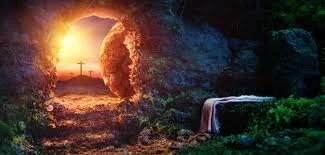God was reluctant to allow us to make representations of him because of the low fidelity of human made representations (Exodus 20:4-6) (Deuteronomy 5:7-9) (Isaiah 44:6-18) (Micah 1:7) (Hosea 13). The understanding of God that human made representations convey materially deviates from the nature of God. Unless we get our representation of God directly from the hands of Jesus himself, the odds are that it is inaccurate. A low fidelity representation of God is of dubious value to us. Better no representation of God than a low fidelity representation of him.
Jesus gave us the best approximation of God - a high fidelity representation of God - in the demonstration of divinity that took place on the road from the Crucifixion to the Resurrection. He did not give us a mere declaration of God in words as priests make declarations from the safety of an ambo. He showed us God in action. He showed us a dynamic God at work in the world. Moreover, on the road from the Crucifixion to the Resurrection, Jesus showed us God within the context of the brutal evil that we did to him. We tortured and killed the God who loves us. We made the God who loves us suffer and die. We impaled the God who loves us on a cross as a fisherman insouciantly impales a live worm on a sharp hook where he hung until death. "Who are you, Jesus? Identify yourself! Friend or foe?" We interrogated Jesus with lash, thorns, nails and cross. It was a brutal interrogation. We gave him the third degree.
In response to our brutal interrogation, Jesus did not stand mute. His tongue did not become tied. He did not take the fifth. The evil that we did to Jesus opened bloody wounds in his body. Jesus transubstantiated his bloody wounds into the floodgates of forgiveness. Through them, the sweet syrup of love in the form of forgiveness boldly poured into the Valley of Tears to dilute its toxicity in the same way that sugar cubes dilute the bitterness of a cup of bad coffee. In the climax to the story of God, Jesus resurrected our understanding of God from the dead. He gave us his gentle answer to the brutal evil that we did to him. Despite the brutal evil that we did to him, Jesus forgave us (Luke 23:34) (Jeremiah 31:31-34) (Matthew 26:28). Jesus forgave us even though we did not deserve forgiveness.
The dial that controls his love for us is in his hands not ours. Moreover, it is set to the highest degree and locked in place (Jeremiah 31:3). Not even the evil that we did to him could budge it (Lamentations 3:22).
Forgiveness was the vehicle that Jesus chose to re-introduce the children of Adam and Eve to God. "... for they shall all know me, from the least of them unto the greatest of them, saith the Lord: for I will forgive their iniquity, and I will remember their sin no more" (Jeremiah 31:31-34) (Luke 23:34) (Matthew 26:28).
Now, that is the high fidelity representation of God that Jesus released into the Valley of Tears on the road from the Crucifixion to the Resurrection. All other answers to the question, 'Who is God?' must yield to Jesus's answer. They must bend the knee (John 3:30).
Peace. Happy New Year!
